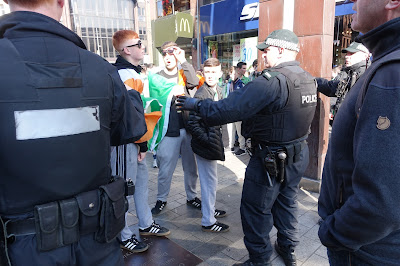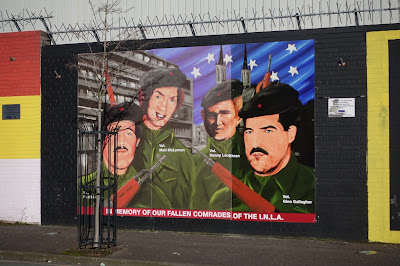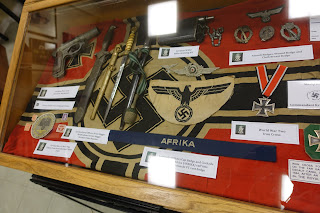St. Patrick's Day Parade on Royal Avenue
Right out in front of city hall a group of protesters-the Loyal People's Protest group-started to gather. While St. Patrick's Day might be a celebration of everything Irish, they wanted to remind all Ulstermen that Northern Ireland stands with the United Kingdom, and not the Republic of Ireland. Some P.S.N.I officers were on the scene, to make sure the protest didn't grow into something dangerous. Almost as soon as the Loyal People's Protest put up their first Union Flag, youths draped in Irish tricolours began to gather on the opposite side of the street.
Unionist Demonstrators at City Hall
Republican Counter Demonstration
Within minutes the small group of youths had transformed into a large crowd, and a fairly tense standoff began. More P.S.N.I officers arrived, forming a bright neon yellow line in front of the Republicans to make sure that the two groups didn't come into contact with each other. However several kids, probably no older than eleven or twelve, sneaked passed the police line and walked right in front of the Unionists-taunting them with Irish tricolours. The P.S.N.I quickly hurried that kids along.
As I mingled among the Republican congregation, I flagged down a young Republican who was willing to speak to me about the situation. In this recording you can hear the background noise of the protest, and I'm very happy to be able to provide a first hand statement by someone who was involved.
I tried to speak to the Unionists after I finished this interview, but they were not interested in talking to me.
Police Line in Front of Republican Demonstrators
Tricolours in Front of City Hall
Tricolours in Front of City Hall
Smoke Bombs at City Hall
Second Smoke Bomb Goes Off
The tension seemed to be dissipating, when suddenly a red flare streaked across the sky, right over the top of a P.S.N.I armoured jeep, and landed right in the centre of the Unionist protest group. The startled Unionsists began cursing and jeering at their Republican adversaries. The situation was taking a turn for the worse, and the P.S.N.I moved in to restore order. Officers grabbed the two boys who threw the flare, and dragged them into the back of a police van. The Republican line collapsed and began to retreat away from the city hall. As the Republicans sang rebel songs, and chanted "I.R.A", police land rovers started to arrive in front of city hall, and police officers in armour formed a line and began to walk the Republicans down Royal Avenue.
Republican Retreat to the Intersection
The Republicans moved back in an orderly manner, and while occasionally a group of teens would form a circle and chant pro-I.R.A slogans; the entire group, which now must have numbered in the hundreds, had moved back at least 200 metres from the Unionists. The Republicans occupied an intersection just North of the city centre, and all roads leading to it were quickly blocked off by armoured land rovers and P.S.N.I officers.
Republicans Now Occupy the Intersection
Hundreds Have Gathered in the Intersection
The police line held, and the boys in blue stopped anyone draped in a tricolour from moving through the line towards the Unionists, but let anyone who wasn't in anything overtly sectarian move through freely. The situation was still tense: kids no more than ten years old were using green spray cans to write I.R.A on their tricolours, and at one point a bottle flew threw the air and slammed onto the bonnet of the lead police land rover.
Police Block the Way to City Hall
Behind the Police Line
Youths Taunt the Police with Tricolours
Youth with IRA Tricolour
Police Stop Sectarian Symbols from Moving Through
Line of Armoured Cars in Front of City Hall
However, in time the mood changed from a sectarian protest to just another Irish St. Patrick's Day party, and even though a lot of the boys had I.R.A written in green ink on their cheeks they now seemed more interested in impressing the girls than in standing up to British rule. People stopped singing sectarian songs, and everybody seemed to want to pose for photos.
Youths Pose for Photographs
Youths Pose for Photographs
Youths Pose for Photographs
The Party Starts to Die Down
This went on for quite some time, around two to three hours, until the police land rovers started slowly inching their way backwards. During that time police officers had managed to infiltrate the crowd and clear up the roads, so they could drive their jeeps through the intersection every now and then. As they started to leave the cleaning crews showed up, and began to try to clean up the whole intersection. It was at this moment that I decided it was time to leave. As I passed through the police line and back towards city hall, I noticed that a group of Republican protesters had been allowed to have a counter demonstration back where the original Republican crowd had gathered.
Protesters Remain in Front of City Hall
For all the effort put into trying to remove the sectarian implications of the St. Patrick's Day celebrations, it's clear that it'll take years for this celebration to become something that everyone in both the Republican and the Unionist communities can cherish.
I actually managed to take about five minutes of video footage of the events, so if you'd like to see it click the link below. I must warn you though, there is foul language.
This weekend is going to see some major celebrations for the 100th anniversary of the 1916 Easter Rising, and I intend to keep you all up to date with the events of the celebrations.
Until next week!
-Luke van Reede van Oudtshoorn




















































